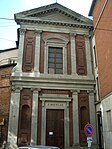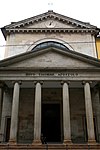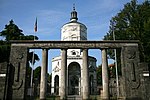San Maurizio al Monastero Maggiore
1518 establishments in Italy16th-century Roman Catholic church buildings in ItalyReligious buildings and structures completed in 1518Renaissance architecture in MilanRoman Catholic churches in Milan ... and 1 more
Tourist attractions in Milan

San Maurizio al Monastero Maggiore is a church in Milan, Northern Italy. It was originally attached to the most important female convent of the Benedictines in the city, Monastero Maggiore, which is now in use as the Civic Archaeological Museum. The church today is used every Sunday from October to June to celebrate in the Byzantine Rite, in Greek according to the Italo-Albanian tradition. It is also used as concert hall.
Excerpt from the Wikipedia article San Maurizio al Monastero Maggiore (License: CC BY-SA 3.0, Authors, Images).San Maurizio al Monastero Maggiore
Corso Magenta, Milan Municipio 1
Geographical coordinates (GPS) Address External links Nearby Places Show on map
Geographical coordinates (GPS)
| Latitude | Longitude |
|---|---|
| N 45.465502 ° | E 9.178921 ° |
Address
San Maurizio al Monastero Maggiore
Corso Magenta 13
20123 Milan, Municipio 1
Lombardy, Italy
Open on Google Maps










